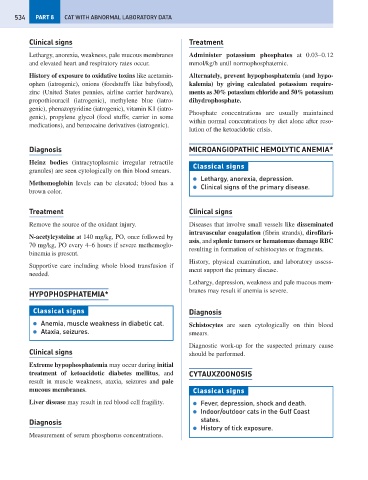Page 542 - Problem-Based Feline Medicine
P. 542
534 PART 8 CAT WITH ABNORMAL LABORATORY DATA
Clinical signs Treatment
Lethargy, anorexia, weakness, pale mucous membranes Administer potassium phosphates at 0.03–0.12
and elevated heart and respiratory rates occur. mmol/kg/h until normophosphatemic.
History of exposure to oxidative toxins like acetamin- Alternately, prevent hypophosphatemia (and hypo-
ophen (iatrogenic), onions (foodstuffs like babyfood), kalemia) by giving calculated potassium require-
zinc (United States pennies, airline carrier hardware), ments as 30% potassium chloride and 50% potassium
propothiouracil (iatrogenic), methylene blue (iatro- dihydrophosphate.
genic), phenazopyridine (iatrogenic), vitamin K1 (iatro-
Phosphate concentrations are usually maintained
genic), propylene glycol (food stuffs; carrier in some
within normal concentrations by diet alone after reso-
medications), and benzocaine derivatives (iatrogenic).
lution of the ketoacidotic crisis.
Diagnosis MICROANGIOPATHIC HEMOLYTIC ANEMIA*
Heinz bodies (intracytoplasmic irregular retractile
Classical signs
granules) are seen cytologically on thin blood smears.
● Lethargy, anorexia, depression.
Methemoglobin levels can be elevated; blood has a
● Clinical signs of the primary disease.
brown color.
Treatment Clinical signs
Remove the source of the oxidant injury. Diseases that involve small vessels like disseminated
intravascular coagulation (fibrin strands), dirofilari-
N-acetylcysteine at 140 mg/kg, PO, once followed by
asis, and splenic tumors or hematomas damage RBC
70 mg/kg, PO every 4–6 hours if severe methemoglo-
resulting in formation of schistocytes or fragments.
binemia is present.
History, physical examination, and laboratory assess-
Supportive care including whole blood transfusion if
ment support the primary disease.
needed.
Lethargy, depression, weakness and pale mucous mem-
branes may result if anemia is severe.
HYPOPHOSPHATEMIA*
Classical signs Diagnosis
● Anemia, muscle weakness in diabetic cat. Schistocytes are seen cytologically on thin blood
● Ataxia, seizures. smears.
Diagnostic work-up for the suspected primary cause
Clinical signs should be performed.
Extreme hypophosphatemia may occur during initial
treatment of ketoacidotic diabetes mellitus, and CYTAUXZOONOSIS
result in muscle weakness, ataxia, seizures and pale
mucous membranes. Classical signs
Liver disease may result in red blood cell fragility. ● Fever, depression, shock and death.
● Indoor/outdoor cats in the Gulf Coast
Diagnosis states.
● History of tick exposure.
Measurement of serum phosphorus concentrations.

